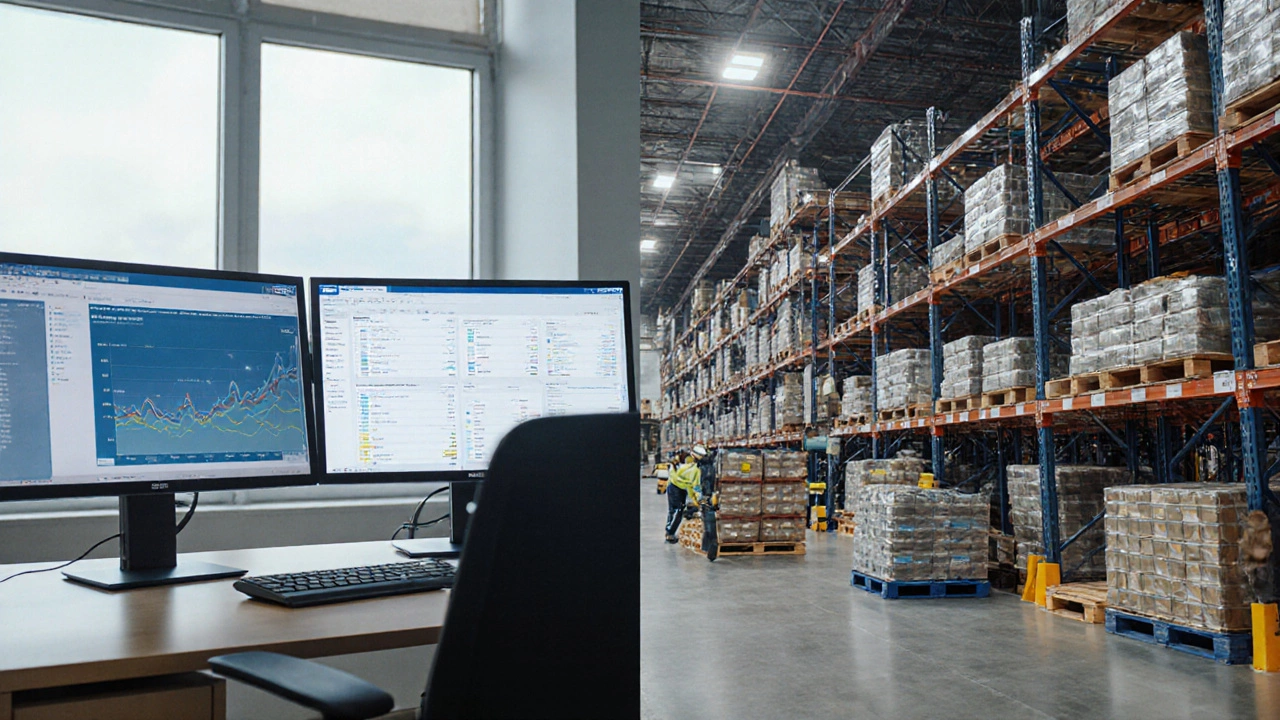SAP ERP vs WMS Decision Guide
SAP ERP vs WMS Decision Guide
Take this short quiz to determine whether you need SAP ERP, SAP WMS (Extended Warehouse Management), or both for your business operations.
When you hear the term SAP, it’s easy to assume the suite is either a pure ERP (Enterprise Resource Planning) system or a dedicated WMS (Warehouse Management System).
Both labels are technically right, but the reality is messier. SAP provides a portfolio where ERP modules handle core business processes while specialized WMS components focus on the nitty‑gritty of moving goods inside a warehouse. This article untangles the overlap, explains where each fits, and gives you a clear path to decide what you actually need.
What does ERP mean in the SAP world?
In SAP parlance, ERP refers to the set of applications that manage finance, procurement, production, sales, and human resources. The flagship platforms are SAP S/4HANA - the next‑generation, in‑memory suite - and the classic SAP ECC (ERP Central Component). Together they give you a single source of truth for everything from order‑to‑cash to record‑to‑report.
Key attributes of an SAP ERP system include:
- Financial accounting (FI) and controlling (CO)
- Materials Management (MM) for procurement
- Sales & Distribution (SD) for order processing
- Production Planning (PP) for manufacturing
- Human Capital Management (HCM) for payroll and talent
If your goal is to harmonise front‑office sales data with back‑office finance and supply‑chain metrics, ERP is the hub.
What is a WMS and why does SAP offer one?
A Warehouse Management System handles the day‑to‑day movement of inventory inside a facility - receiving, put‑away, picking, packing, and shipping. SAP’s answer is SAP Extended Warehouse Management (EWM), a robust, stand‑alone solution that can also run as an add‑on to S/4HANA.
Typical WMS functions include:
- Bin and location control
- Slotting and replenishment algorithms
- Cross‑dock and wave‑picking orchestration
- Integration with material handling equipment (e.g., conveyors, robots)
- Real‑time inventory visibility via barcode/RFID scans
In short, the WMS is the brain that tells workers and machines exactly where to put each pallet, which order to pick next, and how to load a truck efficiently.
How SAP blends ERP and WMS
Even though ERP and WMS serve different purposes, SAP makes them talk to each other through standardized APIs and shared master data tables. A typical flow looks like this:
- An order is created in SAP S/4HANA Sales & Distribution.
- The system checks inventory levels in the ERP’s Material Management module.
- If stock exists, the order is handed off to SAP EWM, which generates a pick list.
- Warehouse staff or robots execute the pick, and the WMS posts the goods issue back to the ERP.
- The ERP then triggers invoicing and updates financial ledgers.
This tight loop eliminates manual data entry, reduces error rates, and gives executives a real‑time view of order fulfillment performance.

When to pick SAP ERP alone
If your operation runs a single or a handful of small warehouses, the built‑in inventory management of SAP S/4HANA may be sufficient. The standard MM module provides basic stock tracking, batch management, and simple put‑away rules. Choosing ERP‑only saves implementation time and licensing costs. Good candidates are:
- Distributor with <10,000 SKUs and fewer than 5,000 daily moves.
- Service‑oriented business that needs inventory visibility but not advanced wave‑picking.
- Companies already invested heavily in SAP ECC and reluctant to add a separate product.
In these scenarios, the ERP’s core strength - financial and supply‑chain integration - outweighs the need for a highly specialised WMS.
When to layer SAP EWM on top
Large, complex distribution centres demand features that go far beyond basic stock control. If you experience any of the following, it’s a signal to add EWM:
- Multiple fulfilment strategies (batch picking, zone picking, pick‑to‑light).
- High‑velocity e‑commerce spikes that require dynamic wave generation.
- Automation equipment such as conveyor‑based sorting or autonomous mobile robots.
- Regulated environments (pharma, food) that need stringent traceability and batch expiry tracking.
- Cross‑dock operations where inbound and outbound moves happen within minutes.
When you layer EWM, you keep the ERP as the financial backbone while delegating all floor‑level logic to a purpose‑built engine.
Comparison at a glance
| Aspect | SAP ERP (S/4HANA/ECC) | SAP EWM |
|---|---|---|
| Core Focus | Financial, procurement, production, sales | Warehouse floor control, picking, packing, shipping |
| Typical Users | Finance teams, planners, procurement officers | Warehouse managers, logistics engineers, automation integrators |
| Implementation Complexity | Medium - requires process mapping across departments | High - needs layout design, equipment integration, advanced configuration |
| Licensing Model | Per‑user or per‑core‑module subscription | Per‑warehouse or per‑transaction licensing, often additive to ERP |
| Real‑time Inventory Visibility | Basic stock levels, batch info | Bin‑level stock, slotting, RFID updates, wave status |
| Automation Compatibility | Limited - mainly barcode integration | Extensive - supports conveyors, AMRs, robotics APIs |
The table makes it clear: ERP gives you the “why” of the supply chain, while EWM tells you the “how” on the floor.

Practical steps for a smooth decision
Use this checklist before you sign off on an SAP investment:
- Map your processes. Sketch the end‑to‑end order flow, noting where manual hand‑offs occur.
- Quantify warehouse activity. Count daily picks, SKUs, locations, and peak‑season spikes.
- Identify technology gaps. Do you need voice‑directed picking, dock‑door scheduling, or robot coordination?
- Assess integration needs. List any non‑SAP systems (e.g., transport management, third‑party logistics) that must sync with your core.
- Calculate total cost of ownership. Include licensing, implementation services, hardware, and ongoing support.
- Pilot before full rollout. Deploy EWM in one zone, monitor KPIs (order cycle time, error rate), and adjust.
Following this path helps you avoid the common pitfall of buying a heavyweight WMS when a thin ERP layer would have sufficed, or vice‑versa.
Real‑world example: A UK retail distributor
Imagine a mid‑size distributor in Manchester handling 2 million line items per year across three regional warehouses. The company runs SAP ECC for finance and procurement but struggles with order‑to‑ship delays because floor staff still rely on paper pick lists.
After a gap analysis, they added SAP EWM to the largest warehouse (1.5 million square feet). Within six months, they saw:
- Pick accuracy rise from 96 % to 99.5 %.
- Order cycle time drop by 22 % thanks to wave‑picking.
- Labor hours reduced by 1,200 per quarter due to automated slotting.
Financially, the ROI materialised in the second year as the same ERP data now fed accurate inventory costs, eliminating costly write‑offs.
Key takeaways
- SAP offers both ERP and dedicated WMS capabilities; they are not mutually exclusive.
- Start with ERP for financial and supply‑chain alignment; add EWM only when warehouse complexity justifies it.
- Use a structured checklist to match business needs with the right SAP component.
- Integration is native - the real challenge lies in process redesign and change management.
Is SAP EWM a separate product from SAP ERP?
Yes. SAP Extended Warehouse Management (EWM) can run as a stand‑alone system or as an add‑on to SAP S/4HANA. It focuses exclusively on warehouse floor operations, while ERP handles finance, procurement, and production.
Can I manage basic inventory with just SAP S/4HANA?
For small to medium warehouses, the built‑in inventory functions in S/4HANA’s Materials Management module are often enough. They cover stock levels, batch handling, and simple put‑away.
What are the licensing differences between ERP and EWM?
ERP licensing is typically per‑user or per‑module, while EWM often uses a per‑warehouse or per‑transaction model that adds to the ERP cost. Exact pricing depends on the deployment (cloud vs on‑premise) and the volume of transactions.
Do I need separate training for ERP and EWM users?
Yes. ERP users (finance, planners) focus on master data, reporting, and order creation, while EWM users (warehouse staff, logistics engineers) learn pick‑path generation, slotting, and equipment integration. SAP provides role‑based learning paths for each.
Can SAP EWM integrate with third‑party transport management systems?
Absolutely. SAP offers standard APIs and IDocs that let EWM exchange shipment data with external TMS platforms, ensuring end‑to‑end visibility from dock to door.





